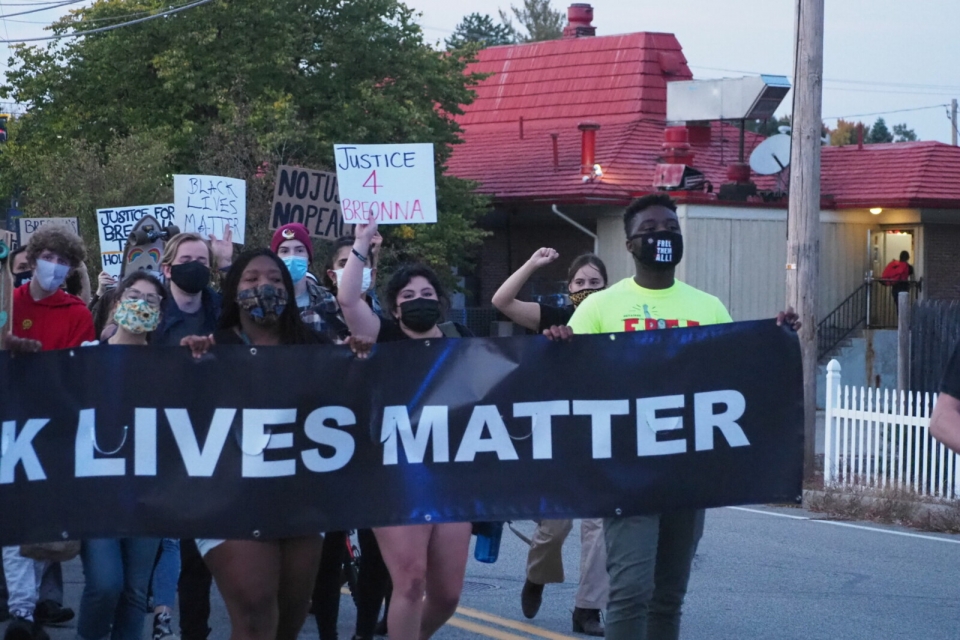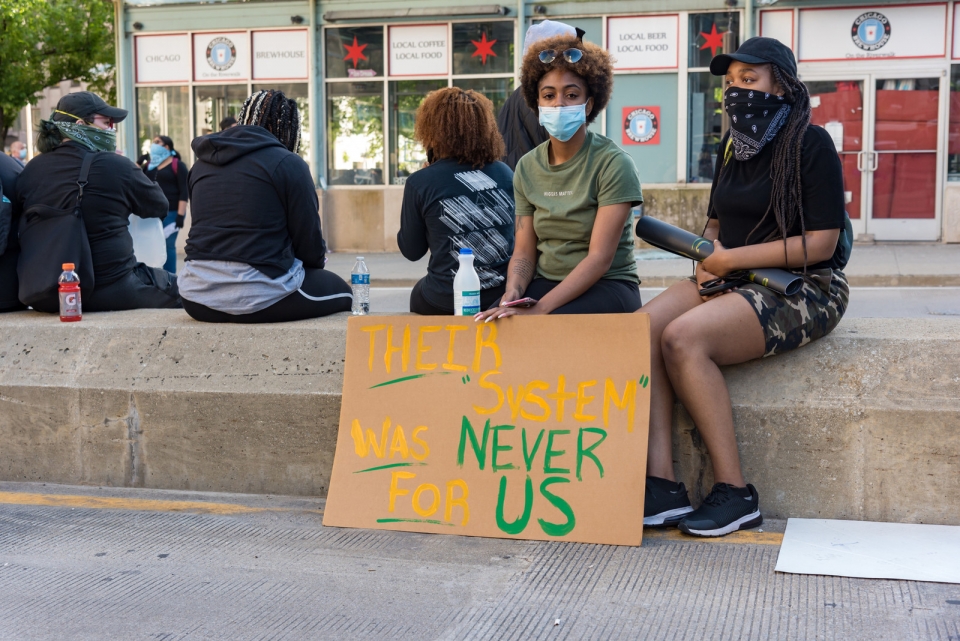
Black Lives Matter protest in Washington, D.C. Carl Roose / AFSC
Calls to defund police became commonplace this summer in the wake of nationwide protests catalyzed by the police murders of George Floyd, Breonna Taylor, and so many others.
You may have been out on the street in support of the call, but maybe you have friends and family who are less sure. Many who support Black Lives Matter and condemn racist police violence are still not comfortable with the idea of reducing policing in their communities. And it can be hard to have a conversation without getting trapped in familiar arguments, especially with some politicians and media outlets using the slogan “defund the police” to sow fears about what reducing police budgets will mean for community safety.
Nevertheless, these difficult conversations are critical to shift the boundaries of what is possible—and to push for the policies we actually need, rather than what is seen as politically feasible.
In reality, we know that many people—including Black, Brown, Indigenous, and trans people and people dealing with mental health issues—are made less safe by the police. “Defund the police” calls us to consider alternatives that allow us to divest from policing and invest in housing, health care, education, addiction and mental health treatment, and other vital services that help communities—especially those that have been chronically starved of those human needs—stay safe and thrive.
So when talking with family and friends, how can we avoid getting stuck in the dominant fear-based narrative about reducing reliance on police? And how can we stay grounded in the reality that this newly popular slogan is actually rooted in years and years of organizing led by Black people demanding justice?
AFSC’s new Community Safety Beyond Policing initiative is creating spaces for people around the country to talk about these issues. That includes monthly webinars for folks who are curious, nervous, excited, or even fearful about defunding the police—but want to learn more and are eager to have these discussions.
We have developed the following tips for talking about the movement to defund the police. Use them to help people you know understand the issue in a new way.
Lead with shared values.

Pre-election polls show that while most people do not support “defunding the police” as a slogan, many do support the values that underlie the #DefundPolice movement.
When talking with people, lead with these shared values, like importance of community, and how all people deserve to live in safety and peace. That could look something like:
- “We all deserve to live in communities where we feel safe, where neighbors can connect with each other and help each other.”
- "Everyone deserves dignity and respect, and every community deserves to have what it needs to thrive.”
Paint a compelling picture of what a community without policing would look like.
For those of us who are white and economically secure, it can be very difficult to imagine dismantling a system that was designed to protect our privilege. Many of us now assume that many common occurrences require a call to lethally armed police, even though police often make situations less safe, and other approaches can be more effective.
Help people envision what life would be like if we established new avenues for responding to common situations or invested more deeply in existing ones. You can use some of the ideas in this popular set of memes, such as:
- You don’t realize that your brake lights aren’t working. Imagine, a city employee signals for you to pull over and asks if they can replace those bulbs for you on the spot so that no one gets hurt? Isn’t that public safety?
- You are experiencing a mental health crisis and afraid. Imagine, you call 311 and a first responder trained in mental health comes to your door. An hour later you are in a safe place with your consent and follow up plans. Isn’t that public safety?
Shift the focus to what we all gain by reducing policing.
Our communities would be so much healthier if we made investments in education, health care, housing, addiction and mental health services, and other critical programs that go unfulfilled, particularly in poor communities and communities of color. We could easily redirect some of the $100 billion U.S. cities spend on policing to make those investments.
Share real life examples where policing has been reduced and how that has improved the community.
Indigenous communities, researchers, community groups, and policymakers have already demonstrated the value of alternative approaches. We can all benefit by investing in and building upon them.
- One example is Crisis Assistance Helping Out On The Streets (CAHOOTS), a mobile mental health crisis intervention team in Eugene, Oregon formed in 1989. They handle 20% of emergency calls in their area, responding in suicide interventions and overdoses.
- Another is Mothers Against Senseless Killings (MASK), a group of mothers in Chicago who have transformed a troubled block into a community without police, which has led to a reduction in violence. The moms are present on the block every evening, barbecuing, feeding residents, and building relationships with the young people. They help diffuse tensions between young people and watch out for police, protecting young people who have been subject to stop and frisk.
Focus on the need for significant and systemic change, rather than reformist measures.
 Some people will tell you about an individual they know who is on the police force who is trying to help the community, as though that invalidates any movement to reduce the scope of policing. Focusing on individuals does not help you shift the narrative. Police and state violence are way beyond “a few bad actors”—the entire system is implicated in a pattern of unjust outcomes and must be transformed.
Some people will tell you about an individual they know who is on the police force who is trying to help the community, as though that invalidates any movement to reduce the scope of policing. Focusing on individuals does not help you shift the narrative. Police and state violence are way beyond “a few bad actors”—the entire system is implicated in a pattern of unjust outcomes and must be transformed.
That is not surprising given that U.S. policing has its roots in slave patrols and night watches, creating a racially directed system of law enforcement from its very beginnings. Additional points to highlight in conversation might include:
- Police in the U.S. were established to maintain white supremacy, protect property, and quell labor unrest. But what we need is an approach to community safety that centers community well-being.
- Mass incarceration does not stop violence. But community-based transformative and restorative forms of justice can—by addressing the root causes of harm and violence.
- Body cameras, trainings, and other so-called reform measures have proven largely ineffective, and have not solved systemic problems. Instead, we should be working with communities to reduce the role of policing while building up institutions that do keep people safe, like unarmed crisis response teams charged with de-escalating situations and connecting people with resources.
AFSC has long worked to transform the system of law enforcement that has targeted Black and Brown people for police violence, incarceration, and death—and to construct systems based on respect, equity, and human dignity. Defunding the police and investing in our communities is an important step toward building a just and peaceful world – one that grows community safety with hope, kindness, and compassion. We hope that you will join us as we work toward that goal.
To learn more about the call to defund the police and how you can lead a conversation in your community, join our Dec. 15th webinar "Train the trainer: Building community safety without police."